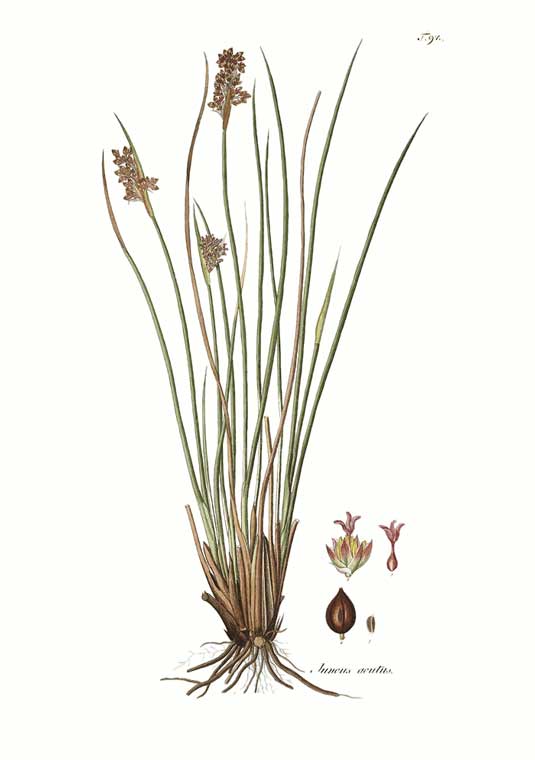Ethnobotany of southern California native plants:
Rush (Juncus spp.)

US Public Domain
Botanical illustration of Juncus acutus, revealing flowers.

Juncus grass growing in the winter near Palm Springs.
Rush (Juncus spp.)
The rushes are the common name for a group of grass-like plants in the juncus genus. These herbs are monocot flowering plants. There are approximately 300 species of grass-like plants in the juncus genus.
Juncus can be found all throughout the world; they’ve clearly hit upon a successful botanical design. In general, these grasses enjoy cold and wet habitats. However, the two species discussed on this page do very well in dry and hot conditions.
Juncus balticus and Juncus acutus are two species of rush that both grow in southern California. Both species were used by Native Americans to create baskets. The rush plants take on a variety of colors, depending on age and growth conditions. Native Americans used the different colors of juncus plants to create beautiful baskets with elaborate designs.
Baltic rush (Juncus balticus)
Juncus balticus is commonly known as Baltic rush. This perennial grass is native to California but is now widespread around the world. Baltic rush can reach a height of 3 feet.
The Kawaiisu people split the stems of the Baltic rush, then interwove these split stems to create coiled baskets.
Sharp rush (Juncus acutus)
Sharp rush, or spiny rush, is the common name for Juncus acutus. This monocot can grow on sand dunes or in salt marshes. Juncus acutus takes on brown and green colors and does well in all types of soil. The plant is considered a reliable tool against erosion.
Juncus acutus is also native to California, however, it is now widespread throughout the world. Its currently considered an invasive plant in Australia.
The Cahuilla people of the Mojave desert used Juncus acutus to create finely woven baskets. These baskets were then used to collect food and to leach acorn meal.
Please return to our main Ethnobotany of southern California page.
On our main ethnobotany page, we present a clickable list of the southern California native plants that became a part of the culture of Native Americans and early European settlers. These plants were used for medicine, food, shelter, drink, tools and art.
Warning: The information about plants on this website is intended for general educational purposes only. The author of this website accepts no responsibility for problems arising from the user’s misidentification, misuse, or use of plants. Please read the full TERMS associated with this website.
